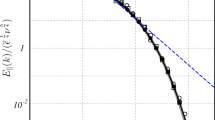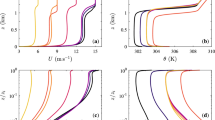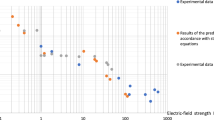Abstract
The results of analyzing a number of models to calculate the statistical fourth-order moments of turbulent fluctuations of vertical velocity and temperature, which describe diffusion processes in equations for triple correlations in RANS models, are presented. Correct calculation of higher-order moments allows adequate description of the impact of large-scale vortex structures on the vertical flow of turbulence energy, as well as the impact of chemical reactions (in the case of reactive impurities) and/or phase transitions (moisture condensation and evaporation) in the atmospheric boundary layer.Results of calculations with the use of the quasi-normality hypothesis, a number of empirical formulas. and algebraic models for fourth-order cumulants are comparedwith in situ measurements in the convective boundary layer of the atmosphere. It is shown that the secondorder- closure models, which are much more efficient in numerical implementation than the thirdorder models, predict the behavior of the higher-order moments not worse than the latter.
Similar content being viewed by others
References
Atmosfernaya turbulentnost’ i modelirovanie rasprostraneniya primesei (Atmospheric Turbulence and Modeling of Impurities., Nistadt, F.T. and Van Dop, X., Eds., Leningrad: Gidrometeoizdat, 1985.
Andre, J.C., De Moor, G., Lacarrere P., Therry, G., and du Vachat, R., Modeling the 24-Hour Evolution of the Mean and Temperature Structures of the Planetary Boundary Layer, J. Atm. Sci., 1978, vol. 35, no. 10, pp. 1861–1883.
Ilyushin, B.B. and Kurbatskii, A.F., Modeling of Triple Correlations in the Convective Atmospheric Boundary Layer, Izv.AN, Fiz.Atm. Okeana, 1998, vol. 34, no. 6, pp. 640–644.
Ilyushin, B.B. and Kurbatskii, A.F., New Models for Computing Third-Order-Moment Model in the Planetary Boundary Layer,Math. Russian Acad. Sci., Atm. Ocean. Phys., 1998, vol. 34, no. 6, pp. 772–781.
Millionshchikov, M.D.,On the Theory of Homogeneous Isotropic Turbulence, Dokl. ANUSSR, 1941, vol. 32, no. 9, pp. 611–614.
Cheng, Y., Canuto, V.M., and Howard, A.M., Nonlocal Convective PBL Model Based on New Third- and Fourth-Order Moments, J. Atmos. Sci., 2005, vol. 62, pp. 2189–2204.
Ilyushin, B.B., Fourth-Order Cumulants Model to Describe Turbulent Transport of Large-Scale Vortex Structures, PMTF, 1999, vol. 40, no. 5, pp. 106–112.
Ilyushin, B.B., Higher Moment Diffusion in Stably Stratified and Swirled Flows, in Closure Strategies for Turbulent and Transitional Flows, Launder, B.E. and Sandham, N.D., Eds., Cambridge Univ. Press, 2001, pp. 424–448.
Raupach, M.R., Conditional Statistics of Reynolds Stress in Rough-Wall and Smooth-Wall Turbulent Boundary Layers, J. Fluid Mech., 1981, vol. 108, pp. 363–382.
Cha,M., Chong, and Pitsch, H., Higher-Order Singly-ConditionalMoment-ClosureModeling Approaches to Turbulent Combustion, Combust. TheoryModel., 2002, vol. 6, iss. 3, pp. 425–437.
Zhang, K., Fu, R., Shaikh, M.J., Ghan, S., Wang, M., Leung, L.R., Dickinson, R.E., and Marengo, J., Influence of Superparameterization and a Higher-Order Turbulence Closure on Rainfall Bias over Amazonia in Community Atmosphere Model Version 5, J. Geophys. Res.: Atm., 2017, vol. 122, no. 18, pp. 9879–9902.
Jovanovic, J., Durst, F., and Johansson, T.G., Statistical Analysis of the Dynamic Equations for Higher- OrderMoments in TurbulentWall Bounded Flows, Phys. Fluids A, 1993, vol. 5, no. 11, pp. 2886–2900.
Gryanik, V.M. and Hartmann, J., A Turbulence Closure for the Convective Boundary Layer Based on a Two- ScaleMass-Flux Approach, J. Atmos. Sci., 2002, vol. 59, pp. 2729–2744.
Hartmann, J. et al., Arctic Radiation and Turbulence Interaction Study (ARTIST), no. 305, Alfred Wegener Institute for Polar and Marine Research Report on Polar Research, Germany: Bremerhaven, 1999.
Daly, B.J. and Harlow, B.E., Transport Equations in Turbulence, Phys. Fluids, 1970, vol. 13, pp. 2634–2649.
Hanjalic, K. and Launder, B.E., A Reynolds Stress Model of Turbulence and Its Application to Thin Shear Flows, J. Fluid Mech., 1972, vol. 52, no. 4, pp. 609–638.
Deardorff, J.W., Closure of Second- and Third-Moment Rate Equation in Homogeneous Turbulence, Phys. Fluids, 1978, vol. 21, pp. 525–530.
Ilyushin, B.B., Modeling Daily Evolution of the Atmospheric Boundary Layer, Izv. AN, Fiz. Atm. Okeana, 2014, vol. 50, no. 3, pp. 282–292.
Mironov, D.V., Gryanik, V.M., Moeng, C.-H., Olbers, D.J., and Warncke, T.H.,Vertical Turbulence Structure and Second-Moment Budgets in Convection with Rotation: A Large Eddy Simulation Study, Quart. J. Roy. Meteor. Soc., 2000, vol. 126, pp. 477–516.
Author information
Authors and Affiliations
Corresponding author
Rights and permissions
About this article
Cite this article
Ilyushin, B.B. Calculation of Higher-Order Moments in the Atmospheric Boundary Layer. J. Engin. Thermophys. 27, 339–344 (2018). https://doi.org/10.1134/S1810232818030098
Received:
Published:
Issue Date:
DOI: https://doi.org/10.1134/S1810232818030098




